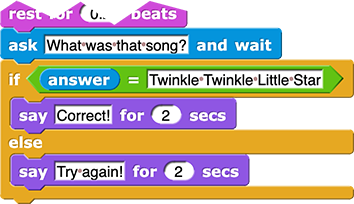 reporter. Snap! also has a built-in command version:
reporter. Snap! also has a built-in command version:

if then else and the command if else.
I like "to choose one of two possible values to report" or "what the block should report." I don't like 'scripts' as I get confused about what scripts mean. - pf 3/3/22
In Unit 1 Lab 6 Activity 2: L33t Text, you used  to decide what the computer should report. You can use the command version to decide what the computer should do. Like the reporter version, the command
to decide what the computer should report. You can use the command version to decide what the computer should do. Like the reporter version, the command if else block takes three inputs:
- A testing condition (such as
 )
) - What to do if it's true
- What to do if it's false
The command block, however, performs a set of commands depending on the result of the condition rather than reporting an output.
I don't disagree with anything you are saying in principle, but in this unit, we are trying to begin preparing them for Snap! as it exists in the wild, and that doesn't have ask. We could go back and make sure they were told that everything they've learned that isn't a primitive isn't a primitive, but instead, we've opted for the to-be-created end-of-unit blocks list that will make the distinction. --MF, 3/6/22
 reporter. Snap! has a built-in command version:
reporter. Snap! has a built-in command version:
 , which uses
, which uses
 to report the user's response.
to report the user's response.
In Unit 1 Lab 7 Activity 3: Collecting Your Data, you used  to ask the user a question and report the user's response. To use Snap!'s built-in version, first use the command
to ask the user a question and report the user's response. To use Snap!'s built-in version, first use the command  to ask the user your question and then use the reporter
to ask the user your question and then use the reporter  to access the answer stored the last time
to access the answer stored the last time ask and wait was run.
agreed, especially as its not obvious how to use a command and a reporter together. -pf 3/3/22
There is an example embedded in the fourth hint. You are looking for something here too? --MF, 3/7/22
 ,
, 
I cant find the ask block :( I think it has to be in the song player project blocks microworld. -pf 3/3/22
This needs to be fixed in all XML files, but for now, I fixed the starter file and added this takeNote box to help anyone who has already saved the problem project. --MF, 3/6/22
I now realize it's missing the "say" block(s). I also think it’d be nice to have the “When flag clicked” block so a student can share a code-less version of the project (otherwise you can see the answer in the code on the left). -pf 3/6/22